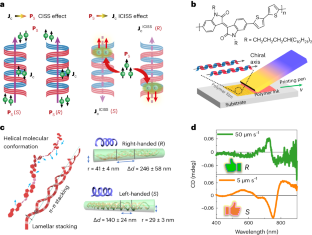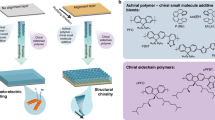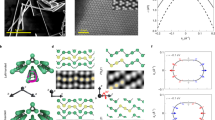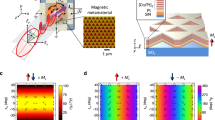Abstract
Coupling of spin and charge currents to structural chirality in non-magnetic materials, known as chirality-induced spin selectivity, is promising for application in spintronic devices at room temperature. Although the chirality-induced spin selectivity effect has been identified in various chiral materials, its Onsager reciprocal process, the inverse chirality-induced spin selectivity effect, remains unexplored. Here we report the observation of the inverse chirality-induced spin selectivity effect in chiral assemblies of π-conjugated polymers. Using spin-pumping techniques, the inverse chirality-induced spin selectivity effect enables quantification of the magnitude of the longitudinal spin-to-charge conversion driven by chirality-induced spin selectivity in different chiral polymers. By widely tuning conductivities and supramolecular chiral structures via a printing method, we found a very long spin relaxation time of up to several nanoseconds parallel to the chiral axis. Our demonstration of the inverse chirality-induced spin selectivity effect suggests possibilities for elucidating the puzzling interplay between spin and chirality, and opens a route for spintronic applications using printable chiral assemblies.
This is a preview of subscription content, access via your institution
Access options
Access Nature and 54 other Nature Portfolio journals
Get Nature+, our best-value online-access subscription
$29.99 / 30 days
cancel any time
Subscribe to this journal
Receive 12 print issues and online access
$259.00 per year
only $21.58 per issue
Buy this article
- Purchase on Springer Link
- Instant access to full article PDF
Prices may be subject to local taxes which are calculated during checkout




Similar content being viewed by others
Data availability
All data in the main text or the Supplementary Information is available upon reasonable request. Source data are provided with this paper.
References
Wolf, S. A. et al. Spintronics: a spin-based electronics vision for the future. Science 294, 1488–1495 (2001).
Soumyanarayanan, A., Reyren, N., Fert, A. & Panagopoulos, C. Emergent phenomena induced by spin–orbit coupling at surfaces and interfaces. Nature 539, 509–517 (2016).
Hirohata, A. et al. Review on spintronics: principles and device applications. J. Magn. Magn. Mater. 509, 166711 (2020).
Hirsch, J. E. Spin Hall effect. Phys. Rev. Lett. 83, 1834–1837 (1999).
Kato, Y. K., Myers, R. C., Gossard, A. C. & Awschalom, D. D. Observation of the spin Hall effect in semiconductors. Science 306, 1910–1913 (2004).
Saitoh, E., Ueda, M., Miyajima, H. & Tatara, G. Conversion of spin current into charge current at room temperature: inverse spin-Hall effect. Appl. Phys. Lett. 88, 2199473 (2006).
Mosendz, O. et al. Detection and quantification of inverse spin Hall effect from spin pumping in permalloy/normal metal bilayers. Phys. Rev. B 82, 214403 (2010).
Sun, D. et al. Inverse spin Hall effect from pulsed spin current in organic semiconductors with tunable spin–orbit coupling. Nat. Mater. 15, 863–869 (2016).
Mosendz, O. et al. Quantifying spin Hall angles from spin pumping: experiments and theory. Phys. Rev. Lett. 104, 046601 (2010).
Hoffmann, A. Spin Hall effects in metals. IEEE Trans. Magn. 49, 5172–5193 (2013).
Sinova, J., Valenzuela, S. O., Wunderlich, J., Back, C. H. & Jungwirth, T. Spin Hall effects. Rev. Mod. Phys. 87, 1213–1260 (2015).
Manipatruni, S. et al. Scalable energy-efficient magnetoelectric spin–orbit logic. Nature 565, 35–42 (2019).
Pham, V. T. et al. Spin–orbit magnetic state readout in scaled ferromagnetic/heavy metal nanostructures. Nat. Electron. 3, 309–315 (2020).
Grimaldi, E. et al. Single-shot dynamics of spin–orbit torque and spin transfer torque switching in three-terminal magnetic tunnel junctions. Nat. Nanotechnol. 15, 111–117 (2020).
Ray, K., Ananthavel, S. P., Waldeck, D. H. & Naaman, R. Asymmetric scattering of polarized electrons by organized organic films of chiral molecules. Science 283, 814–816 (1999).
Naaman, R. & Waldeck, D. H. Chiral-induced spin selectivity effect. J. Phys. Chem. Lett. 3, 2178–2187 (2012).
Naaman, R., Paltiel, Y. & Waldeck, D. H. Chiral molecules and the electron spin. Nat. Rev. Chem. 3, 250–260 (2019).
Göhler, B. et al. Spin selectivity in electron transmission through self-assembled monolayers of double-stranded DNA. Science 331, 894–897 (2011).
Nakajima, R. et al. Giant spin polarization and a pair of antiparallel spins in a chiral superconductor. Nature 613, 479–484 (2023).
Di Nuzzo, D. et al. High circular polarization of electroluminescence achieved via self-assembly of a light-emitting chiral conjugated polymer into multidomain cholesteric films. ACS Nano 11, 12713–12722 (2017).
Kim, Y. H. et al. Chiral-induced spin selectivity enables a room-temperature spin light-emitting diode. Science 371, 1129–1133 (2021).
Crassous, J. et al. Materials for chiral light control. Nat. Rev. Mater. 8, 365–371 (2023).
Kiran, V. et al. Helicenes—a new class of organic spin filter. Adv. Mater. 28, 1957–1962 (2016).
Bullard, G. et al. Low-resistance molecular wires propagate spin-polarized currents. J. Am. Chem. Soc. 141, 14707–14711 (2019).
Kulkarni, C. et al. Highly efficient and tunable filtering of electrons’ spin by supramolecular chirality of nanofiber-based materials. Adv. Mater. 32, 1904965 (2020).
Banerjee-Ghosh, K. et al. Separation of enantiomers by their enantiospecific interaction with achiral magnetic substrates. Science 360, 1331–1334 (2018).
Abendroth, J. M. et al. Spin selectivity in photoinduced charge-transfer mediated by chiral molecules. ACS Nano 13, 4928–4946 (2019).
Chiesa, A. et al. Assessing the nature of chiral-induced spin selectivity by magnetic resonance. J. Phys. Chem. Lett. 12, 6341–6347 (2021).
Aiello, C. D. et al. A chirality-based quantum leap. ACS Nano 16, 4989–5035 (2022).
Chiesa, A. et al. Chirality-induced spin selectivity: an enabling technology for quantum applications. Adv. Mater. 35, 2300472 (2023).
Inui, A. et al. Chirality-induced spin-polarized state of a chiral crystal CrNb3S6. Phys. Rev. Lett. 124, 166602 (2020).
Diao, Y. et al. Solution coating of large-area organic semiconductor thin films with aligned single-crystalline domains. Nat. Mater. 12, 665–671 (2013).
Diao, Y. et al. Flow-enhanced solution printing of all-polymer solar cells. Nat. Commun. 6, 7955 (2015).
Park, K. S. et al. Tuning conformation, assembly, and charge transport properties of conjugated polymers by printing flow. Sci. Adv. 5, eaaw7757 (2019).
Park, K. S., Kwok, J. J., Kafle, P. & Diao, Y. When assembly meets processing: tuning multiscale morphology of printed conjugated polymers for controlled charge transport. Chem. Mater. 33, 469–498 (2021).
Park, K. S. et al. Chiral emergence in multistep hierarchical assembly of achiral conjugated polymers. Nat. Commun. 13, 2738 (2022).
Wittmann, A. et al. Tuning spin current injection at ferromagnet-nonmagnet interfaces by molecular design. Phys. Rev. Lett. 124, 027204 (2020).
Vetter, E. et al. Tuning of spin-orbit coupling in metal-free conjugated polymers by structural conformation. Phys. Rev. Mater. 4, 085603 (2020).
Azevedo, A., Vilela-Leão, L. H., Rodríguez-Suárez, R. L., Lacerda Santos, A. F. & Rezende, S. M. Spin pumping and anisotropic magnetoresistance voltages in magnetic bilayers: theory and experiment. Phys. Rev. B 83, 144402 (2011).
Calavalle, F. et al. Gate-tuneable and chirality-dependent charge-to-spin conversion in tellurium nanowires. Nat. Mater. 21, 526–532 (2022).
Qian, Q. et al. Chiral molecular intercalation superlattices. Nature 606, 902–908 (2022).
Ando, K. & Saitoh, E. Observation of the inverse spin Hall effect in silicon. Nat. Commun. 3, 629 (2012).
Wang, S.-J. et al. Long spin diffusion lengths in doped conjugated polymers due to enhanced exchange coupling. Nat. Electron. 2, 98–107 (2019).
Yu, Z. G. Spin Hall effect in disordered organic solids. Phys. Rev. Lett. 115, 026601 (2015).
Sun, R. et al. Visualizing tailored spin phenomena in a reduced-dimensional topological superlattice. Adv. Mater. 32, 2005315 (2020).
Chen, K. & Zhang, S. Spin pumping in the presence of spin-orbit coupling. Phys. Rev. Lett. 114, 126602 (2015).
Yu, Z. G. Chirality-induced spin–orbit coupling, spin transport, and natural optical activity in hybrid organic–inorganic perovskites. J. Phys. Chem. Lett. 11, 8638–8646 (2020).
Shitade, A. & Minamitani, E. Geometric spin–orbit coupling and chirality-induced spin selectivity. New J. Phys. 22, 113023 (2020).
Yu, Z. G. Spin-orbit coupling, spin relaxation, and spin diffusion in organic solids. Phys. Rev. Lett. 106, 106602 (2011).
Yu, Z. G. Spin-orbit coupling and its effects in organic solids. Phys. Rev. B 85, 115201 (2012).
Lei, T., Dou, J.-H. & Pei, J. Influence of alkyl chain branching positions on the hole mobilities of polymer thin-film transistors. Adv. Mater. 24, 6457–6461 (2012).
Acknowledgements
D.S., Y.D., A.H., W.Y., D.B. and P.Z. acknowledge financial support from the Air Force Office of Scientific Research, Multidisciplinary University Research Initiatives (MURI) programme under award number FA9550-23-1-0311. Device fabrication at NC State University was partially supported by the Department of Energy under award number DE-SC0020992 and the National Science Foundation under award DMR-2143642. Y.D. acknowledges financial support from the National Science Foundation under award DMR-1847828 and partial support by the Office of Naval Research under award number N00014-2220-1-2202. W.Y. acknowledges financial support from the Office of Naval Research under award number N00014-20-1-2181. Z.-G.Y. acknowledges financial support by the US Air Force (FA9550-22-P-0014). A.H. acknowledges financial support from the Illinois Materials Research Science and Engineering Center, supported by the National Science Foundation Materials Research Science and Engineering Centers (MRSEC) programme under National Science Foundation award no. DMR-1720633.
Author information
Authors and Affiliations
Contributions
D.S., Y.D. and R.S. conceived the experiment and supervised this research. R.S. and K.S.P. were responsible for the spin and electron transport measurements. K.S.P., R.S., A.H.C., A.M. and Y.-C.C. fabricated the samples. Z.-G.Y. provided the theoretical models. R.S., P.Z., D.B., W.Y. and A.H. conducted the spin transport analysis. R.S. and D.S. wrote the paper. All authors contributed to editing the paper.
Corresponding authors
Ethics declarations
Competing interests
The authors declare no competing interests.
Peer review
Peer review information
Nature Materials thanks the anonymous reviewers for their contribution to the peer review of this work.
Additional information
Publisher’s note Springer Nature remains neutral with regard to jurisdictional claims in published maps and institutional affiliations.
Supplementary information
Supplementary Information
Supplementary Sections I–VII, Figs. 1–25 and Tables I–III.
Source data
Source Data Fig. 1
CD spectra data plotted in Fig. 1d.
Source Data Fig. 2
Spin-pumping response data plotted in Fig. 2b–d.
Source Data Fig. 3
Hanle effect data plotted in Fig. 3a,b.
Source Data Fig. 4
Summary data of StC conversion efficiency plotted in Fig. 4a, and spin relaxation time summary data plotted in Fig. 4b.
Rights and permissions
Springer Nature or its licensor (e.g. a society or other partner) holds exclusive rights to this article under a publishing agreement with the author(s) or other rightsholder(s); author self-archiving of the accepted manuscript version of this article is solely governed by the terms of such publishing agreement and applicable law.
About this article
Cite this article
Sun, R., Park, K.S., Comstock, A.H. et al. Inverse chirality-induced spin selectivity effect in chiral assemblies of π-conjugated polymers. Nat. Mater. (2024). https://doi.org/10.1038/s41563-024-01838-8
Received:
Accepted:
Published:
DOI: https://doi.org/10.1038/s41563-024-01838-8



